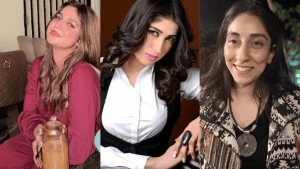When “Hum Kahan Kay Sachay Thay” began airing on our television screens, it promised to be different from the kind of dramas Pakistani audiences were tired of watching. It also had all the appeal with the popular writer Umera Ahmed penning the script, and the star-studded cast including actors like Mahira Khan, Kubra Khan and Usman Mukhtar and also the theme of the series revolving around childhood trauma, which is not something commonly seen before. However sixteen episodes later the series is being regularly criticized by influencers and social media users for the false expectations it set up and proving to be no different from the misogynist and ableist content Pakistani dramas have already been airing. Here we will discuss some of the poor plot points like abuse and problematic characters like Aswad had contributed to the downfall of the show.
Among the most commonly targeted criticism of the show has been the portrayal of women, especially characters like Mehreen (played by Mahira Khan). Before the show’s premier, Mahira Khan sat down for an interview with Something Haute where she described her character to be different from the way Pakistani dramas like to portray poor women since she was a woman abandoned by her parents after her father’s death and was living with abusive relatives, and also had asthma. ‘She is a bitter and cold person because of the trauma she has faced. She isn’t someone who is a bechari and would believe in redemption or forgiveness and she is completely different from the black and white female characters we have seen on our screens before.”
But now we cannot seem to recognize this promise because Mehreen has turned out to be the one-dimensional character who has stuck next to an abusive man and married him despite suffering in her marriage. By the recent episode that aired on Sunday, the audience has watched Mehreen suffering under an abusive marriage where she keeps seeing hallucinations of her dead cousin and is taunted every day by her husband over a crime she didn’t commit, and we’re still waiting for that “strong independent girl” arc to come through.
Pls help me understand why #HumKahanKeSachayThay is still popular? Continued subjugation of Mehreen is getting old. Even her loving Khala sees marrying her off to one man or another as her salvation. A capable, award winning woman reduced to dust – and she accepts it as fate🤬 pic.twitter.com/zvlLZQSj3c
— mh-Musings (@entrespire) November 23, 2021
Let’s get to what is the sole controversy surrounding the show: Aswad. When the audience began the series some people who had read the original novel were aware of Aswad being a villain, but the actor Usman Mukhtar in an interview with BBC Urdu addressed this matter by saying that although the novel had painted a picture of Aswad as a violent man, he had made an effort to tone it down because it wouldn’t send a positive message to the audience. But this toned down version of a “male hero” hasn’t popped up yet or maybe Umera Ahmed and the Hum TV showrunners need to understand that violence is not just physical abuse, but it can be noticed in many different ways. In the most recent episodes Aswad may not have physically abused Mehreen or any other woman, but his actions and behavior towards her fall in the category of abuse. He isolates her from her friends and family members by locking her up in her house, refuses to take her mental health in consideration when in episode 12 she is seen having an asthma attack, he stands there and accuses her for acting for sympathy. In the recent episode, Mehreen can be seen being visibly frightened of Aswad to even drop a teacup and scald her hand when he bangs on a cupboard to scare her. Twitter users have rightfully pointed out that Aswad’s character wasn’t in any way reformed or a break away from the misogyny depicted on screens, but he was the embodiment of what a toxic male hero is.
This was LOW. This was LOW ASWAD #humkahankesachaythay pic.twitter.com/zu8ZHcaIuC
— AsfiYa (@AsfiYaHum) November 14, 2021
The OST just makes this scene so much better #humkahankesachaythay https://t.co/e00j4kpLYU pic.twitter.com/MqG4OPzoNk
— AsfiYa (@AsfiYaHum) November 14, 2021
I don’t see Aswad as a hero. He played with Mashal and ill-treats Mehreen. I just don’t get it how Mashal brainwashed him against Mehreen while she was alive. Why did he play with Mashal’s life like that? You can’t do that to people. Not defending Mashal but still…
— Manimugdha Sharma (@quizzicalguy) November 22, 2021
Much of the criticism has also been directed towards “Hum Kahan Kay Sachay Thay’s” poor plot and tedious pace, that doesn’t seem to progress beyond meaningless interactions between cast members and petty misunderstandings that are stretched beyond two episodes to be resolved. When the episodes began airing audiences found the plot to be promising and quite unique from the usual “family drama’s” aired on screen as it was tackling themes like parental abandonment, abuse and childhood trauma. It even handled female villains like Mashal in a positive manner by portraying her not as a black character, but as someone who had been Mehreen’s childhood friend and companion but became an evil person because of her environment, which audiences had praised the scriptwriter for doing so. However, many twitter users like mental health awareness influencer Maheen Ghani has pointed out the plot of “Hum Kahan Kay Sachay Thay” never gave the audiences a different perspective from the common dramas we’ve watched on our screens but the same misogynist stereotypes are still within the show: the damsel in distress and her unwillingness to leave an abusive marriage, the toxic male lead, the false allegations over a girl for having an affair with another man etc.
Has anyone been watching #humkahankesachaythay -this show & it’s content & moral message are extremely problematic. I am still reeling from the shock of it all. Glorifies suicide ( also no TW given), glorifies abuse, patriarchy, abandonment, child labor!! Where is @reportpemra
— Maheen Ghani (@maheenghani_) November 19, 2021
Other than this users have also began making memes and jokes about how the show runners have squeezed in the chorus of the theme song “Tere Bin” after every small interaction or argument Mehreen has with the rest of the family members, which happens more than once in every episode.
#humkahankesachaythay is all about 1% dialogues and 99% “tere bin, tere binn, tere binnn, tereee binnnn” 🤦♀️🙂 pic.twitter.com/OsZUrV6kOh
— T a a s h a 🦋 (@Shehzadi_Taasha) November 9, 2021
In a 36 mins episode, its just 6 mins of story+dialogue and 30 mins of “Tere bin.. tere bin.. tere binn… tere binn.. tere bin…”
I actually loved the OST but its annoying me now!😭😭😭😭😭@Humtvnetwork bro fix it asap!!#HumKahanKeSachayThay
— 𝑹𝒊𝒎 || 𝑾𝒐 𝒀𝒂𝒉𝒆𝒆𝒏 𝑯𝒂𝒊💫 (@CSidNaaz13) November 21, 2021
Turtles are slow but hum kahan k sachay th is slower#humkahankesachaythay
— 🇵🇰 جویریہ (@Javeriaaaaa) November 22, 2021
For a show that began with a promise that it was bringing a change in how Pakistani dramas had portrayed women previously, “Hum Kahan Kay Sachay Thay” has proven that it was built up on the same regressive stereotypes that audiences wanted to get away from. Aside from wasting time by making audiences watch a living room conversation stretch out to thirty minutes, it also plays into the demeaning representation women already have on screens by glorifying cousin marriages, feuds between two women and now a woman patiently waiting for her abusive husband to change.








